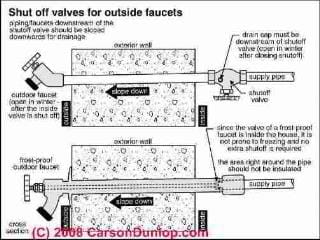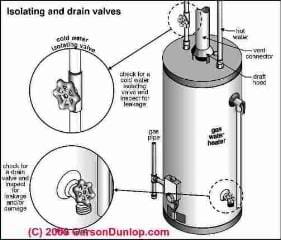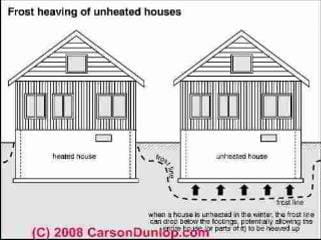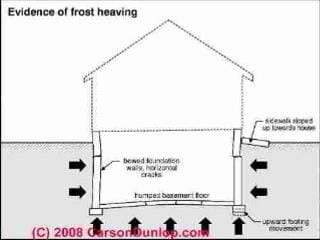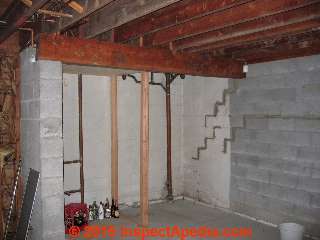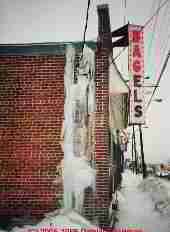 Winterizing Guide, Heat Turned Off
Winterizing Guide, Heat Turned Off
Freeze-Protect Water Supply Piping, Drain Piping, Water Pumps, Tanks, Heaters - Turning HEAT OFF
- POST a QUESTION or COMMENT about winterizing a building with heat off and drained pipes
Winterizing a building: how to freeze proof a building when heat will be turned off:
This article explains with a step by step guide just how to winterize or freeze proof a building when the building's heating system is going to be turned off completely.
We discuss turning off water supply, draining piping and plumbing fixtures, turning off and if necessary winterizing a heating system, and other steps to avoid freeze damage or water, leaks, and mold damage to buildings that are being left in a "shut down" condition.
The articles at this website will answer most questions about freeze protection for piping and other building plumbing and heating system components: how to winterize a building to avoid frozen pipes, and how to thaw frozen water supply & drain piping, wells, & water tanks.
InspectAPedia tolerates no conflicts of interest. We have no relationship with advertisers, products, or services discussed at this website.
- Daniel Friedman, Publisher/Editor/Author - See WHO ARE WE?
How to Winterize a Building If you are Turning the Heat Off - 10 Steps to Freeze Protection
[Click to enlarge any image] Sketch above courtesy of Carson Dunlop Associates.
Is the building heat going to be left "on" or "off" - the answer determines the extent of freeze-proofing needed.
- If heat is to be left ON in a partially winterized building see the procedure
at: WINTERIZE - HEAT ON - If heat is to be turned OFF and the building completely winterized, see the procedure
at: WINTERIZE - HEAT OFF(continuing on this page, just below)
Steps to Winterize a Building with Heat Off
If you have decided to shut down the building's heating system, some steps to protect the building from freeze damage are simple (you don't worry about figuring out the thermostat set-temperature nor about finding "cold spots" where pipes may freeze).
Incidentally, don't make this common mistake: never leave a garden hose attached to your outdoor faucet in winter as water in the hose may add to the risk that the faucet will be freeze damaged. See details about outdoor faucets, hose bibbs, sillcocks
at FAUCETS, OUTDOOR HOSE BIBBS and
at FAUCET, SILLCOCK ANTI SIPHON / FROSTPROOF LEAK REPAIR.
But other critical steps need to be performed if you are going to avoid frozen pipes and future leaks and water damage in a building to be winterized with the heat left off (such as an empty summer cabin, vacation home, or an unoccupied residence.)
- Close the main building water supply valve. Check that the valve really closed fully during the process of draining the piping. Be careful: some valves that are seldom used or which are old may not close off completely.
You just think you've turned off the water supply, but really your water main valve may still be slowly feeding water back into the supply piping.
Details on how to find and use water shutoff valves is
at WATER SHUTOFF VALVE LOCATION, USE. - If a water pump and pressure tank are installed, turn off electrical power to the water pump. (Draining the pump and water tank are discussed below.)
- Drain the building water supply piping; because most homes other than some vacation cottages are not built with piping intended to be periodically drained, there may be long horizontal pipe runs that will not easily drain out all of their water by gravity, or even some supply pipes that slope "backwards" and refuse to drain.
- Use air to remove water: Some plumbers try blowing air through the piping to force out water, or they may install multiple points at which piping can be drained. Below we address some steps to check for frozen, burst piping when turning the water supply back on.
- Cut pipes to remove water: Other plumbers will simply cut open any water supply pipe that may not be draining properly, figuring that it's a much smaller repair to later close that cut connection than to fix a building that has been flooded.
- Use the building drain: Most buildings include a building drain valve located at or near the lowest point in the building supply piping, but "inside" the building or past the main building water supply shutoff valve.
- Drain the building plumbing fixtures, tanks, faucets, such as
- Winterize hot tubs, spas, whirlpool tubs: remove all water from the fixture if possible:
see SPA / HOT TUB DRAIN / WINTERIZING PROCEDURE - Winterize toilets, and remove all toilet water from bowls and toilet tanks. Some winterizing companies pour an anti-freeze mix into building toilets and traps. Some anti-freeze chemicals are toxic and should not be discharged into a septic system. See notes below about use of antifreeze in buildings.
- Winterize water heaters (never turn on electricity to a drained electric water heater, nor turn on power to a gas or oil fired water heater either - it is dangerous and is likely to destroy the heater too)
- Winterize well water tanks and pumps: need to be completely drained of water - a frozen burst in-building water pump adds an expensive repair later
- Winterize all building faucets: after water supply has been turned off, open every faucet and leave it open - water left in a faucet can freeze and break it.
- Open outdoor faucets: be sure also to remove any garden hoses on outside faucets. A garden hose left connected to its outdoor hose hook-up point (the hose bibb) can retain water that freezes and damages the outdoor hose bib (faucet) and can lead to burst piping, leaks, and building damage.
- Winterize the building supply piping: above we recommended removing all water from the supply pipes, cutting pipes if necessary.
To be sure that you have not left water in a hidden corner of supply piping somewhere, if you have not done so, see our tips
at FIND & FIX WATER PIPE FREEZE-UP POINTS discussed under the "heat-on" winterization notes.
If your incoming municipal water supply piping is not well below the frost line it may be necessary to find or even install a water shutoff valve closer to the connection of your building's water piping to the municipal water main. Private water supply systems are easier to shut down but also need to be drained.
- Turn off and drain the water softener or other water treatment equipment.
See details at WINTERIZE WATER SOFTENER & WATER TREATMENT EQUIPMENT.
This article explains water softener shut-down procedure, explain why we use the water softener bypass valve, and how that can reduce the risk of freeze damaged pipes, leaks, and even indoor mold growth.
A separate article WATER SOFTENER / TREATMENT TURN-ON provides details on returning a shut-down water softener to operation after it has been shut down.
- Winterize all building drains: if you have not already done so, review our tips
at DRAIN FREEZE PROTECTION which was discussed under the "heat-on" winterization notes. Further steps include removing traps and use of a non-toxic antifreeze in traps or toilets that cannot easily be removed or emptied of all water.
Empty or remove building fixture traps; see our note below about use of antifreeze.
Use of antifreeze to winterize a building: Be careful: unless the anti-freeze is specifically designed for winterizing a building it could be highly toxic (such as automobile antifreeze).
We do not recommend using toxic antifreeze to winterize a building since later you're moving that contaminant into the public sewer or into soils (and possibly ground water) around a private septic system. Only inside of closed water systems such as a heating boiler do we recommend use of anti-freeze mix in a building.
This sketch of a gas-fired water heater and its control valves is provided courtesy of Carson Dunlop Associates, a Toronto home inspection, education & report writing tool company [ carsondunlop.com ].
Warning: do not drain a water heater tank before first turning off its energy source: oil, gas, or electricity.
Heating an empty water tank is very dangerous and is likely to quickly destroy the tank or its heating elements.
- Drain the hot water tank, well tank, & other building water tanks: the hot water tank and drain the water pressure tank and pump itself if a private well and tank system are installed.
See WATER TANK & PUMP DRAIN & WINTERIZE - how to drain the water tank or well tank and if your water pump is above-ground how to drain the pump itself
See WATER SOFTENER / TREATMENT TURN OFF - about turning off water softeners and, if heat is to be turned off, drain the softener and any other water treatment equipment. - Protect well piping from freezing: If your water supply system's piping is not below the frost line your water system should include protection against well or lake water freeze-ups. But sometimes a building's water supply piping that has never frozen before will freeze when no water is run during long periods of freezing weather.
See SNIFTER & DRAIN BACK VALVES - Shut down & drain or freeze-protect the heating system when all other steps to protect the building have been completed:
- Winterizing forced warm air heating systems: as long as your heating system does not use any water piping (such as a water-to-air system) you can shut off the furnace when leaving a building shut down.
- Winterizing hot water heating systems: Drain the building heating boiler and heating supply piping, or install an anti-freeze mix in the heating boiler and its supply piping.
See ANTIFREEZE for BOILERS
Opening manual air bleed valves can help drain water out of the heating system piping.
See AIR BLEEDER VALVE USE STEPS
Notify your oil heat supplier if you are turning off heat in the building, and remember to notify them again when it is turned back on. - Winterizing steam heating systems: drain the heating boiler and condensate lines and condensate pump if a pump or pumping station are used.
- Winterizing electric heat or warm air furnaces: can simply be turned off.
Watch out: for all oil or gas fired heating equipment (furnaces, boilers, water heaters) we recommend having the heating equipment cleaned before shutting it down - a step that will avoid corrosion, clogs, and trouble when heat is later turned back on.
...
Reader Comments, Questions & Answers About The Article Above
Below you will find questions and answers previously posted on this page at its page bottom reader comment box.
Reader Q&A - also see RECOMMENDED ARTICLES & FAQs
On 2021-12-07 by Inspectapedia Com Moderator (mod) - How Long Can You Safely Leave a Building Winterized?
@Mark George,
Thanks that's a great question.
Question: How long can we safely leave a building winterized.
Answer: no time at all, or several years. It depends...
When a building is shut down as we describe on this page, nothing in that technical shut-down is causing direct or active harm to the building or its mechanical systems. So in that sense it could be left shut down for years.
Sources of Damage to a Winterized Building
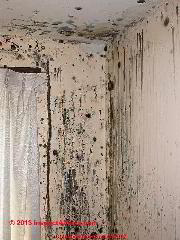 But, and this is a big concern:
But, and this is a big concern:
When a building is left absolutely un-attended, even simply over the course of days, much less months or years, it is at risk of serious damage from the following:
- water leaks from any source: roof, storms, broken or leaky windows or doors
- wind or storm damage, ground-water, flooding, earhquake, landslide, mudslide, etc.
- pest invasion
- malicious mischief - break-ins
And any of these can leave a building so damaged that it deteriorates so rapidly that even in a few days the damage can be so extensive and so serious that the building has to be gutted before it can be restored.
The photo that I attach here is from an insurance claim investigation I performed for a large insurance company. You can see that the home's interior is badly contaminated by mold - so badly that the home had to be gutted to the raw framing before it could be restored.
The cause: a burst pipe in the basement flooded the building. A burst and un-drained pipe in the basement flooded that space.
The result was a soaking wet building up-state New York that was left un-attended, un-inspected, for three months.
But a water leak can occur even in a well-winterized building if a window breaks and snow blows-in, or if shingles blow off of a roof or a branch punctures a hole in it. Something as un-expected as a bird flying-into and breaking a window can expose a home to significant water entry and damage.
Best solution: set up building monitoring
- Leave electrical power on at least to circuits that power security cameras, temperature monitoring devices, and strategically placed water detection devices all of which can notify a monitoring person by cellphone should a problem ensue.
and/or - Hire a reliable service person who makes regular inspections of the building and who can warn the building owner in time to take immediate steps to prevent very expensive damage.
How Often to Check on a Winterized Building
The frequency needed for live on-site monitoring visits and inspections depends on the specific building's properties, site, and geographic location, and a risk-assessment by an experienced building professional. Some example questions:
- what is the range of weather conditions like rain, heavy snow fall, high wind? Wildfire? Storm damage? Proximity to large bodies of water or other geographic hazard or damage sources?
A building in Grand Marais Minnesota, close to Lake Superior is more vulnerable to storm damage than a building in downtown Camden, New Jersey.
- what is the risk of malicious mischief? Downtown Camden, New Jersey has a different risk of break-in than downtown Grand Marais, Minnesota.
- what are the condition of the building's roof, windows, doors, flashings
- what is the building's leak history?
- what are the building's materials and how vulnerable are they to water damage
Examples of How Buildings are Managed when Left Shut Down for Years
Example1: In the Hudson Valley of New York State if a home in a residential neighborhood is to be left empty for a month, and if the home has a bulletproof roof (standing seam metal) and no history of water entry, and if we're leaving the home with water turned off and winterized, we'd still want an inspection once a week and if there were a neighbor who would make a walk-around, even just outside or peeping into windows every few days that'd be better.
Example 2: In a small peaceful town in central Mexico, a home in a residential neighborhood and constructed of adobe - materials less-likely to be destroyed by water entry or mold - may need to be monitored for security, break-in's and if water is not turned off, for burst-pipe water damage. We'd install security cameras and depending on their extent we may want regular inspections for security and damage detection as well.
On 2021-12-07 by Mark George - can a building be left winterized and shut down for several years?
Once the building is winterized with RV solution can it continually be winterized and shut down for several years?
On 2020-11-11 by (mod)
I would do three items listed on this page. Of course it's possible that your home has something else that needs to be drained.
On 2020-11-10 by John Williams
If I have all my utilities turned off & water blown out of pipes, all electric turn off , what else need be done to winterizes this empty house?
On 2019-02-24 by (mod) -
Bob that should work, as long as the piping is pitched enough that water doesn't simply sit in horizontal piping or regulator or valve.
On 2019-02-23 by Bob Worthington
I have a lake house in northern Ohio. Each winter we turn off heat and drain pipes. This year my pressure regulator cracked. Here's the setup: Water pipe enters house about 3 ft below ground level into my crawl space. 18" of water pipe and there is a a cut-off valve to turn water off completely from rest of house; 18" later is my pressure regulator.
Above the pressure regulator is another cut-off valve, which I use to drain the cold water lines of the house; since it is above the pressure regulator, it's guaranteed that there will be water in the regulator all winter..
My question is: Can I move the drain value to below the pressure regulator; would water, not under pressure, drain "backwards" through the regulator, so I can drain all the water and simultaneously drain the pressure regulator?
On 2017-12-19 by (mod) -
Robert
In a freezing climate people like to install the main shutoff inside of the structure as close to the point of water main entry as feasible. The valve is drained by installing a shutoff that includes a small screw cap outlet intended for draining water out of the valve itself.
The main building piping, if it needs to be drained, should be sloped to drain down to a low point where a stopcock is installed to permit draining.
On 2017-12-18 by robert
Where to install the water shut off valve for cabin on a slab hooked to main water line. And how to drain?
On 2016-10-22 by (mod) -
Wally,
I'm too scared to bet your house and money on a promise that wood floors in will be okay in a home about which I know almost nothing.
Certainly by proper winterizing as described in this article series you can minimize the risk of damage from leaks or from frozen, burst piping. However in my OPINION, there is always a risk of some cracking or unexpected movement in building materials, especially drywall and sometimes flooring, both wood and tile flooring, when a building is left to below-freezing temperatures.
The best you can do is to properly drain everything. Better would be regular inspections to check that nothing surprising has occurred, like a broken window or a blown-off roof shingle and concomitant leaking. In many areas of southern Ontario there are people living year round in areas where many homes are closed-up for winter and who will for a fee make regular checks on the homes for damage.
On 2016-10-21 by Wally
Our home is located in southern Ontario & is built over a crawl space. Foundation walls are cement block, below frost line & have blown in insulation. We go south for the winter & want to turn off the heat. Plumbing will be totally drained & antifreeze. Windows are new. Will the wooden furniture & floors be ok?
On 2015-11-23 by (mod) -
Wade if you are turning heat OFF then you want to open all valves and drain all piping in the building.
If you are leaving the heat on in an otherwise winterized building, make sure that the heating boiler (if your heat is by hot water) is assured of having a working water supply. Other supply valves to other parts of the building can be shut off - that reduces the chance of an extensive flood should one of the water supply pipes burst.
On 2015-11-23 by Wade
Which indoor water valves to switch off for winterization?
On 2015-11-23 by (mod) -
Lynda, few places in Mexico suffer from hard freeze conditions - tell me where you are located. In general if you are not leaving water filled pipes or drains that are subject to freezing you should be fine. That is to say water and an open culverts that freezes should not damage system
On 2015-11-22 by Lynda Caton
Hi there,
I have gravity feed water system,the water comes out of the creek as needed and fills a five foot in diameter culvert which feeds into a two inch water line, I am away for the winter and have drained and put recreational antifreeze in all the drains and toilets in the house, should I drain the culvert reservoir as well?
Thanks so much,
worried in Mexico
On 2015-11-03 by (mod) -
Keep us posted; if you like send me some photos of the set-up via our email found at the page bottom CONTACT link and I may be able to comment further.
DF
On 2015-11-03 by Anonymous
Thanks! I'm heading down this weekend, so I'll give it a try.
On 2015-11-02 by (mod) -
I would not use a PSI above the maximum PSI that your water system can deliver - that should be more than enough to reach the highest water in highest pipe in the building. I would consider installing a suitable fitting and blowing "down" through the structure from a convenient high point or points.
On 2015-11-02 by Brad
Dan, that's very helpful. I have heard gurgling in the past when I've shut the water supply off and opened faucets. Can you recommend a minimum psi/volume for a compressor to blow the pipes out? Thanks!
On 2015-11-02 by (mod) -
Good question, Brad and I'm sorry to have to equivocate; as Mark Cramer says ... it depends. If the home was constructed to be winterized then all of its pipes would slope down to drain points; if not the risk is that even when you open lines to drain, enough water may remain in an upwards sloping section to freeze and burst a pipe.
If you hear gurgling at the *end* of your manual drain-effort I'd be worried.
On 2015-10-30 by Brad
We have a vacation house on the extreme southern end of the Jersey Shore. This year we are planning to winterize without heat. (It has a hot-water boiler with baseboard and radiators.) Are we far enough south that draining all the pipes would be enough, or do we need to blow them out? Thanks
On 2015-10-27 by Leaving Maine for the winter
We are planning to completely shut down our house this winter and have hired a knowledgeable plumber to drain the entire heating and water systems and treat all the traps. My question has to do with food in my pantry.
Will all my glass jars of food explode because of the freezing? And my canned goods - will they all push out damaging the seals? I figure any liquors are safe, but what about wines? We are leaving soon, so a quick reply is greatly appreciated.
Question: Winterizing the heating system: Is it OK to drain un-used heating zone piping, baseboards and radiators?
I have a boiler with 5 heating zones. I am living alone in a big house and do not use the rooms for 3 of the zones. I would like to know if I can drain those zones so they don't freeze and just use the 2 remaining zones for heat.Thank you - Anon
Reply:
Sure, provided your heating zones are individual piping loops, and that you have control valves at both ends of the un-used heating zones, you can drain them and leave them turned off.
At AIR BLEEDER VALVES we describe air bleed valves found on hot water heating systems. These valves, normally used to purge trapped air that can cause cold radiators or baseboards, can also be opened to make it easier to get water out of the heating system piping when the building is being drained so as to leave heat off completely.
Watch out: to get all of the water out of the piping. It can be difficult to get water out of long horizontal pipe runs without blowing air through the system. For this reason some winterizing companies actually cut the heating pipes, planning to repair them when the building heat is restored. Don't forget to check for cut or burst heating pipes later when de-winterizing the building.
More details about how to winterize the heating system when you are going to leave heat "OFF" are found
at Winterize- Heat Off Procedure.
Also see how WINTERIZE A BUILDING
Question: Winterizing the heating system: Can I put antifreeze in the heating system instead of draining it?
I've read the other parts of your website as you suggested and I hope you don't mind more questions.Instead of trying to drain the heating zones I don't need, can I just put a non-toxic antifreeze in the whole boiler system? It sounds easier if it is a good solution.
Thanks again!
Reply: use an antifreeze intended for use in heating boilers and piping
Sure, there are specific antifreeze products intended for use in hot water heating systems.
Also see WINTERIZE A BUILDING
Question: Winterizing the heating system:Can I shut off the first radiators in the heating zone without losing heat in the rest of the house?
I have such a system, and only one zone. The thermostat is located in the warmest room in the house. Causing frigidity and numbness of extremities in other areas of the home.
Since the location of the thermostat is also where the first radiator is in the home, can I "shut off" that baseboard radiator, and the next one, without losing heat to the rest of the home? - Jacke
Reply: It depends ... on how heating piping is arranged
Jacke
Whether or not you can shut off or turn down the first two radiators or baseboards in your home to improve heat distribution depends on how the piping is arranged.
If all of the baseboards are piped in series (which is usual for single-zone hot water baseboards) then the input of each baseboard is fed directly from the outlet of the one prior. In that case you can't turn off any baseboard because 1. you have no shutoff valve installed and 2. more important, you'd be shutting off all hot water flow through the system.
If you have radiators, heating convectors, or even some baseboard installations that are piped in parallel, that means that there will be a loop of hot water heating piping that runs through the buildings and that off of that loop, individual risers and returns feed individual radiators or convectors (heating baseboard is not usually piped this way).
In this second case it would be possible to turn off an individual radiator or convector.
So part of my long answer is due to confusion on my part - you use the terms radiator, then baseboard radiator - so I'm not sure what you've got.
Let us know the details - what we learn will assist others.
Question: How to Add antifreeze for hot water heating piping
how do i add antifreeze to my boilers baseboard heating system - Gene Griswold 7/22/12
Reply:
Gene, please search InspectApedia for
"Guide to Fixing an Air-Bound Hot Water Heating System - Procedure#2," and you will see an article on how a service tech uses a pony pump and fittings to place antifreeze into a hydronic heating system.
Question: emergency steps to avoid freeze damage
(Jan 28, 2014) Tracy said:
Help! NE North Carolina, 9-12" snow expected, possible power outages & probable road closures so leaving b4 we CAN'T leave..planning to drain piping but leave heat on...if I don't drain water heater & power goes, how long might it be safe b4 water in heater to freeze & should I leave wh breaker on or off? PLEASE HELP QUICKLY! I HAVE ONLY 3 HRS TIL LEAVE TIME!!!
Reply:
Review the checklist at
WINTERIZE - HEAT ON PROCEDURE
the link is at More Reading
At a bare minimum: if you expect power to be off, turn off the building water supply.
That should minimize the extent of leakage that can occur if a supply pipe breaks.
Then on return to the home go through our De-Winterizing checklist - basically you will turn heat on and water on and check for leaks.
Question: some heat left on to avoid interior cracks
(Nov 5, 2014) Deborah Frenette said:
I wonder if it is true that in an unheated home that damage can occur to the walls and floors caused by the extreme cold? WE plan to not waste $$ on heating this year. my smart hubby has done all that is needed to protect the water supply. thank you.
Reply:
Yes Deborah, in extreme cold some building materials may show signs of cracking or movement. I've seen this show up as drywall cracks and on a few occasions fine cracks in ceramic tile floors on a concrete slab.
For this reason, while it is still possible and even reasonable to leave heat off completely (with proper winterizing) for modern construction and where a building is not being left for an extended period such that we are trying to eliminate heating costs completely, I prefer to keep some low heat in the building to try to keep it a bit above freezing.
(Nov 5, 2014) Deborah said:
thank you! WE are not using the building (my office, it is attached to our big house) and that is why we are turning off the heat. I will show this to my hubby. The heating bill for an empty building is getting too high. But we do not want to have to repair cracks in the walls!
Reply:
Deborah
You might see no cracking at all - a lot depends on the particular details of construction including materials, connectors, foundation type, basement vs slab, and importantly, water under and around the building.
If the building is more than a decade old you might have some clues by noting whether or not settlemnt or other cracking has ever occurred.
Question: antifreeze for traps and toilets vs. environmental contamination
(Jan 14, 2015) Anonymous said:
house in pa had oil burner 4 heat got wood burner heats house now also electric hot water heater new in years to come what are the steps to close oil stoker down for long extended time need all steps thank you ed
(Feb 3, 2015) Crafty said:
We have a camp that we regularly dump antifreeze into the traps and toilets because it is left unheated. I absolutely hate this, so I've been looking for a way to get around it, or at least minimize how much is needed.
Would love to eliminate some traps if possible, but does anyone have a recommended non-toxic antifreeze, until I get around to finding a solution? I think I'll just buy a bunch of that to keep there. We try to use RV antifreeze as it's supposedly bio-degradable, but we've allowed people to bring their own, and they don't always comply. I hate to be dumping toxins into the ground.
Reply:
Crafty there are food grade antifreeze products used in RVs and water systems. Those products should not be harmful. If you let visitors use whatever they bring we've lost control of the problem and may be killing off the septic system to boot.
Reader Question: How can we test for possible foundation damage if we leave our home with heat off completely?
We built our home 15 years ago. It is a split level with concrete foundation. When we retired we stated to spend our winters in a warmer climate (we live in N. Ontario). Every winter we have left some heat on the lower level of the house keeping the temperature around 4c.
However with the increase in the cost of oil and our dwindling income buying power, we have been thinking of ways we could cut off both the hydro and the oil heater. Is there any way of us testing what effect this might have on the concrete foundations?
The foundation is covered with a layer of ceramic tiles which we later covered over with a laminate flooring. Thank you. - C.W., northern Ontario
Our sketch (left, courtesy of Carson Dunlop Associates ) shows what happens when a home is left with heat off in a freezing climate.
Reply: Tests for possible frost damage to foundations? try these local research topics
I don't know of an actual test that you can perform to predict foundation damage if the heat is left off completely in your building, since testing would require creating the actual freezing conditions and would itself risk building damage. Sketch at left, showing evidence of frost heaving is provided courtesy of Carson Dunlop Associates, a Toronto home inspection, education & report writing tool company [ carsondunlop.com ].
At "A Common Source of Vertical Frost Heave - Un-heated Homes" found in our article
VERTICAL MOVEMENT IN FOUNDATIONS we discuss the problem of foundation damage in un-heated homes.
And at FROST HEAVE / Expansive Soil Cracks in Slabs we provide more details.
Sketch (left, courtesy of Carson Dunlop Associates ) shows upwards as well as horizontal frost pressure on a building and it indicates where cracks and dislocation commonly appear.
Here are some things you can check:
- Where is the home located? In northern Ontario your home is not at the same level of risk as the far north, but we agree that frost damage is a real risk.
- How is the home constructed? In those same extreme climates builders use a floating slab design or other methods intended to avoid differential heaving or settlement of the structure.
- How deep are your foundation footings and basement or crawl space slabs? If the footings and slabs are well below the frost line (which should be the case) then frost heaving of the slab or footings should not be a significant risk.
- Is there exterior foundation insulation installed? Foam foundation insulation on the building exterior increases resistance to frost damage.
See BUCKLED FOUNDATIONS due to INSULATION? for a discussion of the role of foundation damage and foundation insulation on the interior side of the building foundation walls
- Is there already evidence of frost cracking, heaving, or damage to the building foundation walls, footings, or floor slabs? (See our photo at left). If so you can figure that with heat off this damage will increase.
See FROST HEAVE / EXPANSIVE SOIL CRACKS in SLABS
also
see HORIZONTAL MOVEMENT IN FOUNDATIONS (horizontal frost push, for example)
and
see VERTICAL MOVEMENT IN FOUNDATIONS (frost heave, for example). - Are any neighboring homes suffering frost heaves or damage? Ask your neighbors who live in similar construction and on similar soils what their experience has been.
- Check with local building officials. Your building department may have someone whose experience can shed light on the risk of frost damage to homes in your area.
- Check with local foundation repair companies. As with building officials, local foundation repair companies or masonry contractors will be experienced with frost damage to homes in your area.
Watch out: other factors can still cause slab or foundation damage due to frost.
- Wet soils around the home convert to ice and cause higher amounts of soil movement during freezing.
- Ice lensing - sticking of wet soils to the foundation walls - can cause frost heaves and foundation damage even if the bottom of the foundation and all slabs are well below the frost line.
See ICE LENSES, FROST HEAVES vs. FROZEN SOIL PRESSURE
Well drained soils and good roof drainage that keeps water well away from the building reduce these risks.
Other Steps to Reduce the Cost of Heating Left On to Avoid Frost Damage
An alternative to turning heat off in the building entirely is to continue your practice of leaving heat on at a low setting (4 C or about 40 F) but take measures to protect the building from damage (possibly allowing a slightly lower heat setting) and to reduce heating cost by finding and fixing drafts, air leaks, or by improving building insulation.
See WINTERIZE - HEAT ON PROCEDURE
...
Continue reading at ANTIFREEZE for BOILERS or select a topic from the closely-related articles below, or see the complete ARTICLE INDEX.
Or see these
Building Freeze Protection Articles
- ARTESIAN WELL FREEZE PROTECTION
- CHEMICAL TOILET FREEZE PROTECTION
- DE-WINTERIZE a BUILDING
- DRAIN FREEZE PROTECTION
- FAUCETS, OUTDOOR HOSE BIBBS
- FREEZING FORCE of ICE
- FROST HEAVES, FOUNDATION, SLAB
- FROZEN AEROBIC SEPTIC or WATER SUPPLY SYSTEM
- FROZEN PIPE THAW-OUT
- GREYWATER FREEZE PROTECTION
- PIPE FREEZE PROTECTION - home
- PIPE INSULATION CHOICES, MATERIALS, TYPES
- SEPTIC TANK & DRAINFIELD FREEZE PROTECTION
- SPA / HOT TUB DRAIN / WINTERIZING PROCEDURE
- WATER SOFTENER / TREATMENT TURN OFF
- WINTERIZE A BUILDING - home
- WINTERIZE - HEAT ON PROCEDURE
- WINTERIZE - HEAT OFF PROCEDURE
- WINTERIZING an RV or MOBILE HOME
Suggested citation for this web page
WINTERIZE - HEAT OFF PROCEDURE at InspectApedia.com - online encyclopedia of building & environmental inspection, testing, diagnosis, repair, & problem prevention advice.
Or see this
INDEX to RELATED ARTICLES: ARTICLE INDEX to BUILDING FREEZE PROTECTION
Or use the SEARCH BOX found below to Ask a Question or Search InspectApedia
Ask a Question or Search InspectApedia
Try the search box just below, or if you prefer, post a question or comment in the Comments box below and we will respond promptly.
Search the InspectApedia website
Note: appearance of your Comment below may be delayed: if your comment contains an image, photograph, web link, or text that looks to the software as if it might be a web link, your posting will appear after it has been approved by a moderator. Apologies for the delay.
Only one image can be added per comment but you can post as many comments, and therefore images, as you like.
You will not receive a notification when a response to your question has been posted.
Please bookmark this page to make it easy for you to check back for our response.
IF above you see "Comment Form is loading comments..." then COMMENT BOX - countable.ca / bawkbox.com IS NOT WORKING.
In any case you are welcome to send an email directly to us at InspectApedia.com at editor@inspectApedia.com
We'll reply to you directly. Please help us help you by noting, in your email, the URL of the InspectApedia page where you wanted to comment.
Citations & References
In addition to any citations in the article above, a full list is available on request.
- "New Electric Heat Tapes Help Prevent Fires," US Consumer Product Safety Commission (CPSC) #00936
- Mark Cramer Inspection Services Mark Cramer, Tampa Florida, Mr. Cramer is a past president of ASHI, the American Society of Home Inspectors and is a Florida home inspector and home inspection educator. Mr. Cramer serves on the ASHI Home Inspection Standards. Contact Mark Cramer at: 727-595-4211 mark@BestTampaInspector.com
- John Cranor [Website: /www.house-whisperer.com ] is an ASHI member and a home inspector (The House Whisperer) is located in Glen Allen, VA 23060. He is also a contributor to InspectApedia.com in several technical areas such as plumbing and appliances (dryer vents). Contact Mr. Cranor at 804-873-8534 or by Email: johncranor@verizon.net
- "Freezeproof Your House," Mike McClintock, Rodale's New Shelter, p. 30, October 1985 (approximate date)
- "How to Winterize Your Pipes," Mike McClintock, Homeowners How-To Magazine, p. 59-62, Nov-Dec 1979.
- In addition to citations & references found in this article, see the research citations given at the end of the related articles found at our suggested
CONTINUE READING or RECOMMENDED ARTICLES.
- Carson, Dunlop & Associates Ltd., 120 Carlton Street Suite 407, Toronto ON M5A 4K2. Tel: (416) 964-9415 1-800-268-7070 Email: info@carsondunlop.com. Alan Carson is a past president of ASHI, the American Society of Home Inspectors.
Thanks to Alan Carson and Bob Dunlop, for permission for InspectAPedia to use text excerpts from The HOME REFERENCE BOOK - the Encyclopedia of Homes and to use illustrations from The ILLUSTRATED HOME .
Carson Dunlop Associates provides extensive home inspection education and report writing material. In gratitude we provide links to tsome Carson Dunlop Associates products and services.


